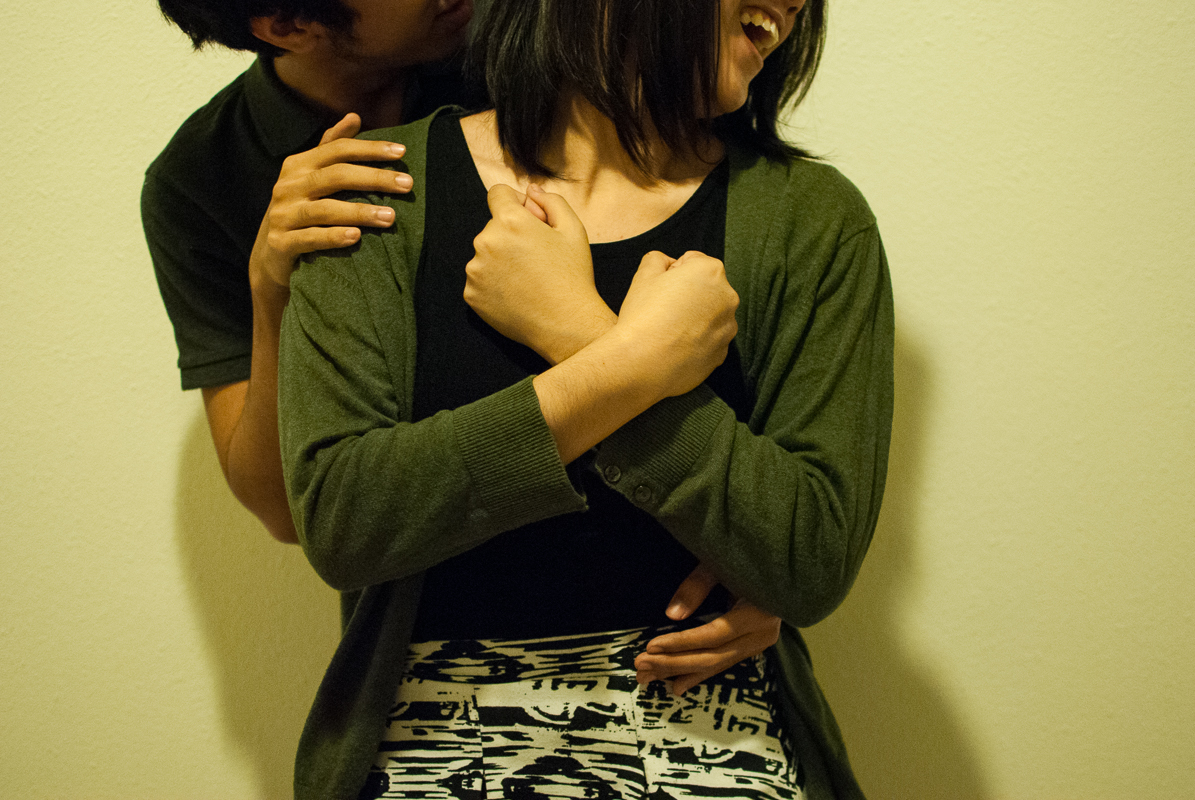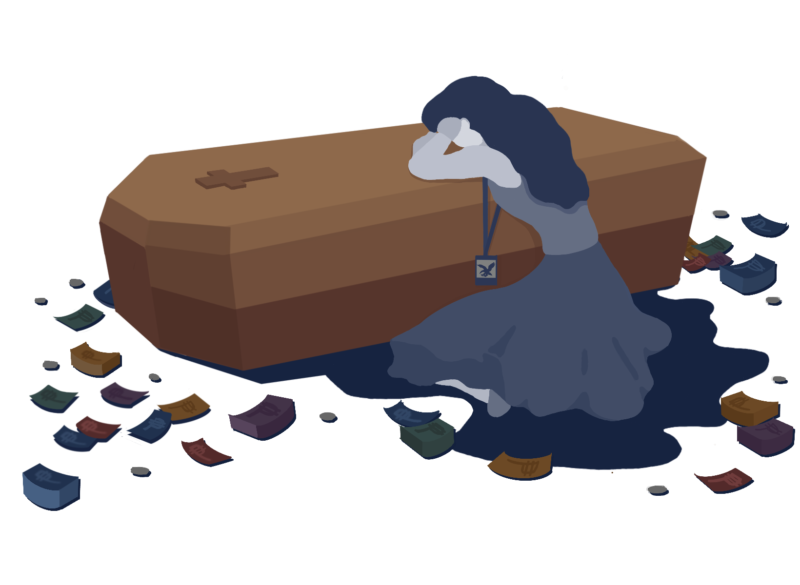This is the story of a boy in a dapper suit and a girl in a pretty dress. There are other boys and girls around them, mingling, laughing and drinking. Through the crowd, his eyes seek out hers and she holds her ground. They move to a room with their friends. She sits on the bed. He sits, uninvited, beside her.
They drink as they begin to talk. She tells him about herself, how complicated her life is and that she only wants to be friends. He nods his head, says they’re friends and he’s fine with that. By now, the room is quiet save for the soft snores of those who slumber. Soon, with flushed cheeks and the drink coursing through their systems, they, too, fall asleep.
This is not a love story.
This is not a love story because she wakes up in the middle of the night to kisses, from the boy, that she does not consent to. She wakes up to his body on top of hers, invading her space, pressing her for more when she never wanted to give him any. He begins to drag her around the room, kissing her despite her protests and pleas. The alcohol is still in her system; the sleep is still clouding her mind.
She struggles. Her voice goes unheard. She blacks out.
In the months that follow, the girl finds it difficult to heal. She tries to seek comfort and sympathy but not even her friends can offer her those things. They call her naïve. In her mind, she hears whispers trailing her wherever she goes, the insults sounding more familiar with every step she takes: Loose. Easy. Slut.
Desperate to come to terms with the sexual assault she had experienced at the hands of a schoolmate, she runs to the one place in the Loyola Schools (LS) where she believes she will find peace: The Office of the Associate Dean of Student Affairs (ADSA).
Legal constraints
Unfortunately, reporting sexual harassment to ADSA does not necessarily mean that the office will sanction a victim’s harasser immediately. The case will still have to be reviewed, and sometimes Philppine law and the rules of the LS work against the favor of the victim, especially when it comes to defining what sexual harassment is.
According to the online edition of Section 3.1: Student-Related Government and Administrative Acts and Implementing Guidelines, and the addendum to the LS Undergraduate Student Handbook, the Ateneo’s primary legal basis for its Anti-Sexual Harassment Policy is Republic Act No. 7877 (RA No. 7877), also known as the Anti-Sexual Harassment Act of 1995.
Section 3 of RA No. 7877 states that an act of sexual harassment is committed when someone who has “authority, influence or moral ascendancy over another in a work or training or education environment, demands, requests or otherwise requires any sexual favor from the other, regardless of whether the demand, request or requirement for submission is accepted by the object of said Act.”
Yet this definition can be quite limiting. In simpler terms, the only offender that the act recognizes is one who has influence over the victim, and these cases are contained only in work- or education-related environments. Thus, there are no provisions for cases wherein it is peer-against-peer, or subordinate-against-supervisor; neither does it take into consideration any incidents that may occur outside the workplace or the school grounds. As the Ateneo bases its policy on this Act, the same constraints apply to what the university considers as sexual harassment.
Processes
ADSA Rene San Andres says that sexual harassment cases are considered criminal. He relates an incident wherein an Atenean’s parents filed a complaint against a staff member for sexually harassing their child. In this case, the process is more serious and complex, and the complainants are free to take the case to court. In this particular case, there was a divide. His office, naturally, sided with the student and the student’s parents. Meanwhile, the staff union backed its member.
“You don’t need an anti-sexual harassment rule to pursue a case against a person,” San Andres says, stressing that there are other options available. In peer-to-peer cases of sexual harassment, for example, the victims need look no further than Item B: Offenses Against Persons, Section III of the LS Student Handbook’s Code of Discipline. Students may use any of the provisions to file an administrative case against the offender.
Once the complaint is received, San Andres says ADSA informs the person against whom the complaint is filed. The accused is interviewed, and his or her statement is examined along with that of the complainant’s. ADSA looks for more evidence and collects testimonies from witnesses, if available. Once everything is in place, and the complaint is deemed a chargeable offense, the office moves on to prosecution.
Under this particular set of offenses, the limitation of the act of sexual harassment being recognized only if the offender is of higher authority than the victim does not apply. Not all incidents need to be situated in the campus. San Andres says that as long as it is an official school function, or the name of the school is dragged into the affair, ADSA may file an administrative case against the offender.
It is these particular procedures that management sophomore Isabella*, the girl in the pretty dress, hoped would aid her in telling her story.
Upholding human dignity
Isabella recounted her experience to one of the personnel in ADSA, in a bid to find out what could be done, as the one who had sexually harassed her was a fellow Atenean. It did not end well. She felt that her complaint was not taken as seriously as it should have been, with the opening question being, “Were you drunk?”
The personnel then offered to arrange a counseling session at the LS Office of Guidance and Counseling (LSOGC) for Isabella and her harasser to talk things out and understand what had happened. At that point, Isabella balked. She couldn’t even be at ease when passing by the guy in hallways—to ask her to stay in a room with him and talk to him, while a stranger presided, was unthinkable. Neither did she warm to the personnel’s suggestion of filing a temporary restraining order against her sexual harasser.
It was “very strange that there [seemed to be] no protocol for these cases,” she says.
When told the story, San Andres denies that Isabella’s experience is the standard procedure for treating these cases. He adds that he is bothered by the reception of Isabella, as when a case like this arrives at the office, the primary concern is to stabilize the emotions of the person and re-empower him or her. He says that the process is fair to everybody, and that as long as the grounds are clear, ADSA will assist the victim in seeing the case to the end.
“Prosecution is not the first and only thing you have to do,” San Andres points out. He says that ADSA can provide counseling or psychiatric treatment, as the important thing is to address the psychological well-being of the victim. He then explains that ADSA has a core team of four offices to tend to the needs of students-at-risk: the ADSA itself, the Office of the Associate Dean of Academic Affairs, the LS Office of Health Services and the LSOGC.
The perils of speaking up
In spite of the existence of systems for members of the LS community to pursue those who have sexually harassed them, there is still a marked reluctance on the part of the victims to speak up. 2011 data on the compliance of higher educational institutions with RA No. 7877 show that at least “49 complaints from private higher education institutions were reported to [the Commission on Higher Education].”
San Andres affirms the rarity of such cases being reported, describing the complaints as “coming in trickles” compared to the steady stream of cases of dishonesty being filed in the office everyday. These numbers seem to suggest that cases of sexual harassment don’t happen all that often.
Yet those numbers represent only the stories that make it past the victims’ walls to the desks of those who can help them. There are many who choose to forget the incident and move on from it without considering legal action or psychological therapy.
According to Dr. Peter Gatmaitan, LSOGC director, this is due to the trauma accompanied by a lot of mixed emotions that are experienced by the victims. Their safety, he adds, has been threatened and violated. Then there is the doubt: “Did I do anything to contribute to the situation?”
Fear is also a part of the equation, especially in occasions when the victims may be asked to face the perpetrators. Gatmaitan says that in these cases, a no-contact agreement between the offender and the victim can be arranged with ADSA. Feelings of shame also rise to the surface, particularly when the victim chooses to pursue legal action, and is concerned as to how his or her peers and family members will perceive him or her as a result.
Isabella admits that the reason why she found it hard to even think of filing a case was that she was afraid she would be blamed. It was her word against his, and when she’d confided in a friend, what she got in return was the accusation that it was her fault for courting trouble. “Why are they going to trust me over him?” she reasons.
A universe of persuasions
These days, Isabella is a little wary, a little more guarded. She is afraid for her friends and siblings, who may very well experience similar things.
This is why she feels that there is a need for the Ateneo to address the issue, not only by having better support systems and protocols in place, but also by raising awareness within the community. Most of all, she says, “I think [the Ateneo needs] to privilege the voices of the people speaking up, that are abused, more than the voices of the abusers themselves.” This will address the issue of victim-blaming, which is what happens when people think that the victim of sexual harassment somehow provoked the attack on him or her.
For his part, San Andres says that it is difficult for ADSA to highlight a particular issue too much. Since there are so few sexual harassment cases brought to the office in comparison to the allegations of dishonesty, the latter is prioritized. Thus, he appeals to the mechanisms that have the reach, such as school publications and advocacy groups.
“There is a whole universe of persuasions,” he says. “As long as [it’s] non-discriminatory, look for a platform. You have a cause–promote it.” He adds that it may be too much of an expectation to ask the administration to do it, as the offices have limited time, resources and personnel.
Isabella is recovering, though she can’t quite shake off all of her demons just yet. “It’s such a dangerous state to be in when you’re drunk and no one’s looking out for you,” she says. She tells the story of another girl, drunk and passed out, being carried out by a bunch of guys to their car. Her voice shakes when she wonders out loud if the girl even knew them, if the guys had good intentions.
“But then, there I was, not doing anything,” she says quietly. “And there was everybody else, not doing anything.”
Editor’s Note: The name has been changed at the request of the interviewee.
Untold stories
By Nicolo A. Fortuna
Sexual harassment is not a rare occurrence, but it is rarely talked about. It is not often that a victim speaks openly and publicly about his or her own first-hand experience, and it is not difficult to understand why. Coming forward does not seem to do much good for them. There are no guarantees that their harassers face consequences, and when this is possible, it is hard-won. Either way, victims then bear a burden: One of strained social situations and of a struggle to be taken seriously.
Even just talking about it privately is difficult. Telling a story involves a kind of reliving the experience and its associated discomforts and distresses. It brings back feelings of fear, confusion, solitude or powerlessness. All the more reason, then, that a story told should be celebrated for the teller’s courage.
Here, three students from the Loyola Schools share their stories. They differ from one another, but undoubtedly each is very similar to many of the other untold stories out there.
Andrea Beldua
Before entering the Ateneo, information design senior Andrea Beldua met a group of males at a college entrance examination review center. Her behavior around them had been liberal and she did not care to be demure. Eventually, in college, she had met another classmate of theirs—her future (ex)boyfriend—and the two started to get close. She had once, unintentionally, glanced a text that one of his classmates had sent him, joking that she was a “free-for-all.” Confronting him about it, she learned that one of them posted her bikini photos on their private Facebook group and that many made crude comments about passing her around or lining up to take turns.
She says he was afraid to stand up to his classmates, and that when she tried to do so herself, they got mad at her for it. She wrote about it for a project in her sophomore year class in general psychology, and placed the actual conversations that they had on her blog, but with their names blotted out. They threatened to take the issue to the Office of the Assistant Dean for Student Affairs or even outside legal arbitration, but eventually backed off when she called them out on their bluff.
Amy*
Amy was going through a time of personal troubles. A friend had invited her over to drink with him and some of their mutual friends, but it somehow ended up just being the two of them. As the night and the drinking went on, she wasn’t really sure at what point she realized that she was not okay with how touchy he was getting. “When the person doing it is someone you trust, it’s so hard for you to realize at that moment that you’re not okay, and you just don’t know how to react,” she says.
She didn’t stop his advances as he went from stroking her arm to resting his hand on her leg. “It was only a few days later when my body started to react that I realized that I wasn’t okay with what happened.”
The stroking was the beginning of what eventually became a kiss, one she did not expect and immediately pulled away from. She didn’t say anything about it at first and just tried asking for a ride back to Katipunan Avenue. He went in for another and she had to tell him “no.” He went for it anyway.
Marie*
When Marie was 11, she had a male best friend whom she was really close to. For some reason, her phone number had gotten to her best friend’s 33-year-old uncle who used to always pester her with phone calls and text messages.
Marie says these phone calls and text messages were lewd. He mentioned a lot of “sexual terms and acts,” and that he “was trying to get me to do stuff.” She recalls that he explained what oral sex was and even tried to teach her how to masturbate.
Understandably, she says she only realized this was harassment when she got older.
Editor’s Note: Names were changed at the request of the interviewees. Andrea Beldua is a member of the Photos Staff of The GUIDON.








hi vicah! could you please give me the number of rene san andres? and PM me yours?